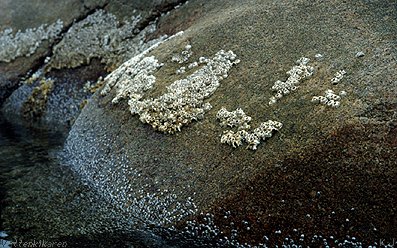|

|
|
The Northern rock barnacle usually mates
during the autumn or early winter. After the mating season the penis is
thrown away, and a new one developes the following year. The eggs and
sperm are stored in seperate mantle
cavities a few months before mating takes place and fertilization
can occur. The eggs hatch later and the resulting larvae
stay with their mother until there is enough plankton in the spring.
Cannot regret their choice of dwelling
place
After a few weeks
in the water, it is time for the now roughly 0,5 mm large larvae to
find a dwelling place. When they have transformed into the adult stage,
and attached themselves to a rock where they no longer are mobile or able
to change their place of dwelling. To find a suitable dwelling place,
the larvae look for adults of their species. Where other barnacles live,
the conditions should be suitable enough for the young to survive, and
close enough to other individuals so mating can occur at a later date.

|
Bands
of barnacles that have developed over different years. Usually,
larvae try and attach themselves to areas which are already colonised
by adults, but because of variations
in sea-level, e.g. because of the weather, the larvae cannot
always reach the same level as earlier larvae.
|
|

|
Page
3 of 7
|

|
|

![]()